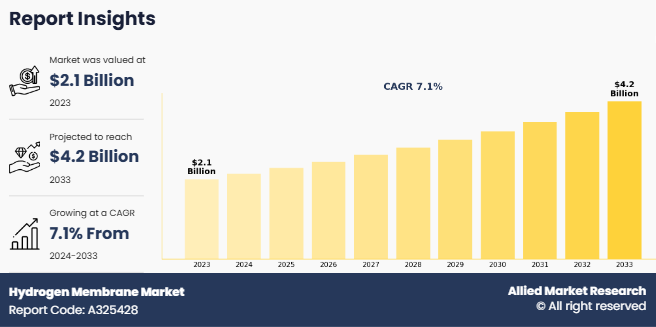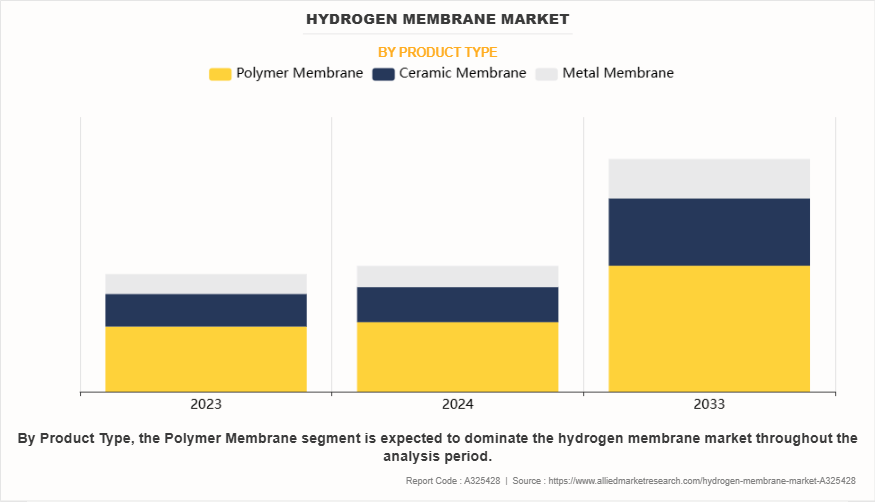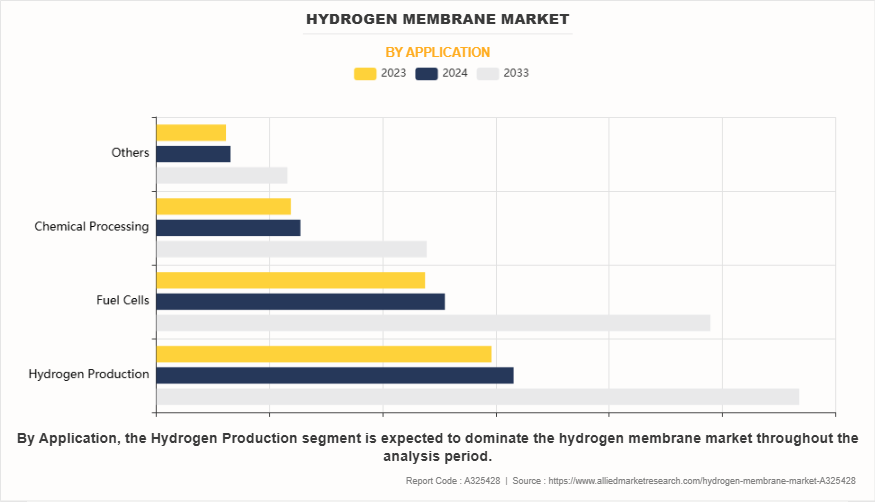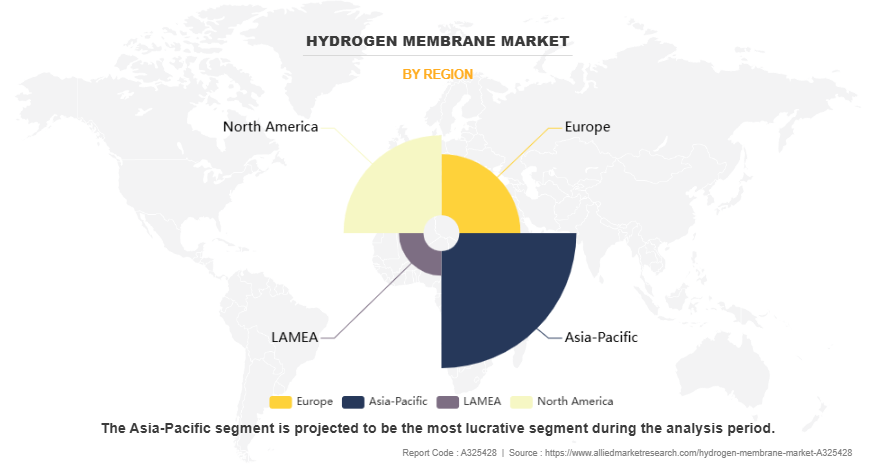Hydrogen Membrane Market Research, 2033
The global hydrogen membrane market size was valued at $2.1billion in 2023, and is projected to reach $4.2billion by 2033, growing at a CAGR of 7.1% from 2024 to 2033.Increasing investments in hydrogen infrastructure and fuel cell technologies are driving significant growth in the hydrogen membrane market. As governments and private sectors worldwide prioritize clean energy solutions, hydrogen-powered vehicles are emerging as a key component of the transition to sustainable transportation. The growing adoption of fuel cell electric vehicles (FCEVs) necessitates efficient hydrogen production, storage, and distribution, which heavily rely on advanced hydrogen membranes for separation and purification.

Introduction
Hydrogen membranes are advanced materials designed to selectively separate hydrogen gas from mixtures containing other gases. These membranes play a critical role in hydrogen purification, production, and utilization, making them indispensable in various scientific, industrial, and environmental applications. Efficient and effective hydrogen extraction and purification are crucial for advancing a hydrogen-based economy, where hydrogen acts as a clean and sustainable energy source. Hydrogen membranes are at the forefront of this transition, offering innovative solutions to address the challenges of hydrogen separation and purification.
Key Takeaways
The global hydrogen membrane market has been analyzed in terms of value ($billion). The analysis in the report is provided on the basis of product type, application, 4 major regions, and more than 15 countries.
The global hydrogen membrane market report includes a detailed study covering underlying factors influencing the industry opportunities and trends.
The key players in the hydrogen membrane market include JSC Grasys, Agfa-Gevaert Group, The Chemours Company, Air Liquide, Linde PLC, Evonik Industries AG, Nitto Denko Corporation, Borsig GmbH, Parker Hannifin Corporation, TORAY INDUSTRIES, INC., and others.
The report facilitates strategy planning and industry dynamics to enhance decision making for existing market players and new entrants entering the alternators industry.
Countries such as China, the U.S., Canada, Germany, and Brazil hold a significant share in the global hydrogen membrane market.
Market Dynamics
Hydrogen, as a clean fuel, has gained significant attention due to its ability to produce zero emissions when used in fuel cells, making it a key component of the transition to cleaner energy systems. Hydrogen's potential to decarbonize sectors such as transportation, power generation, and heavy industry is driving its increasing adoption. For example, hydrogen fuel cells are being integrated into vehicles, including buses, trucks, and trains, as a clean alternative to conventional fossil fuels. The hydrogen economy is expanding, with various regions prioritizing the development of hydrogen infrastructure to support clean energy solutions. This expansion creates a growing demand for efficient hydrogen separation and purification technologies, including hydrogen membranes, to ensure the purity and quality of hydrogen gas. All these factors are expected to drive the growth of the global hydrogen membrane market during the forecast period.
However, hydrogen production relies on specialized facilities, such as electrolyzers and steam methane reformers, which are not yet widely available in many regions. While some areas are advancing in building hydrogen production plants, the infrastructure necessary for large-scale, cost- effective production remains underdeveloped in many parts of the world. This limits the availability of hydrogen and increases costs, making it harder to scale up the hydrogen economy.
In addition to production challenges, hydrogen storage and transportation also face significant limitations. Hydrogen, being a low-density gas, requires high-pressure tanks or cryogenic systems for storage, which can be costly and technically demanding. Lack of extensive network of hydrogen refueling stations and pipelines further complicates the transportation of hydrogen over long distances. Without a reliable and expansive distribution system, hydrogen cannot be efficiently delivered to where it is needed, whether for fuel cells in vehicles, industrial processes, or power generation. All these factors hamper the global hydrogen membrane market growth.
The expansion of the hydrogen economy is one of the most significant drivers of growth in the hydrogen membrane market. As governments, industries, and research institutions worldwide ramp up efforts to reduce carbon emissions, hydrogen has emerged as a key player in the clean energy transition. This growing focus on hydrogen has led to substantial investments in hydrogen infrastructure, such as production, storage, transportation, and distribution networks. These investments are vital for establishing a sustainable hydrogen ecosystem that can support various industries and applications, including energy, transportation, and manufacturing. All these factors are anticipated to offer new growth opportunities for the global hydrogen membrane market.
Segments Overview
The hydrogen membrane market is segmented into product type, application, and region. On the basis of product type, the market is categorized into polymer membrane, ceramic membrane, and metal membrane. On the basis of application, the market is divided into hydrogen production, fuel cells, chemical processing, and others. Region-wise, the hydrogen membrane is Analyzed across North America, Europe, Asia-Pacific, and LAMEA.

On the basis of product type the market is categorized into polymer membrane, ceramic membrane, and metal membrane. The polymer membrane segment accounted for more than half of the hydrogen membrane market share in 2023 and is expected to maintain its dominance during the forecast period. Polymer membranes also find usage in electrolysis systems for hydrogen production, where they serve as the electrolyte in proton exchange membrane electrolyzers (PEMEs). These systems use electricity to split water into hydrogen and oxygen, with the polymer membrane ensuring efficient ion transport and gas separation. The high efficiency and compact design of PEMEs make them suitable for renewable energy integration, such as coupling with solar or wind power for green hydrogen production. Innovative polymer membranes are being integrated into advanced hydrogen storage systems, particularly in solid- state storage technologies. In such systems, membranes facilitate controlled release and absorption of hydrogen in hydride materials, optimizing storage efficiency and enhancing safety by preventing unwanted leakage. These membranes also help in balancing pressure differentials, making storage solutions more reliable for mobile and stationary applications.

On the basis of application, the market is divided into hydrogen production, fuel cells, chemical processing, and others. the hydrogen production segment accounted for more than two-fifth of the hydrogen membrane market share in 2023 and is expected to maintain its dominance during the forecast period. Hydrogen membrane facilitate the separation of hydrogen from oxygen generated during the electrochemical splitting of water. Advanced proton exchange membranes (PEMs) are commonly used in applications such as fuel cells, electrolyzers, and energy storage systems, offering high efficiency and compact design.
These PEMs are key to the adoption of green hydrogen production, as they work seamlessly with renewable energy sources such as wind and solar power. In addition, membranes are employed in pressure swing adsorption (PSA) systems and thermal or catalytic cracking of ammonia. In PSA, membranes enhance the efficiency of separating hydrogen from other residual gases, such as nitrogen and argon. In ammonia cracking, membranes selectively separate hydrogen generated from the decomposition of ammonia, enabling the use of ammonia as a hydrogen carrier for transportation and storage.

On the basis of region, Asia-Pacific dominated the hydrogen membrane market in 2023. The Asia-Pacific region is emerging as a critical player in the adoption of hydrogen membranes, driven by increase in energy demands, decarbonization goals, and push toward clean energy solutions. Hydrogen membranes are primarily used in hydrogen purification and separation processes, enabling the production of high-purity hydrogen for industrial, energy, and transportation sectors. Countries such as Japan and South Korea are leading in the adoption of hydrogen membranes. These nations have robust hydrogen strategies focused on integrating hydrogen into their energy and transportation systems. Hydrogen membranes are utilized in fuel cell vehicles, where they ensure the purity of hydrogen to optimize fuel cell performance.
The major players operating in the hydrogen membrane industry include JSC Grasys, Agfa-Gevaert Group, The Chemours Company, Air Liquide, Linde PLC, Evonik Industries AG, Nitto Denko Corporation, Borsig GmbH, Parker Hannifin Corporation, TORAY INDUSTRIES, INC., and others.
Competitive Analysis
Key players in the hydrogen membrane market include JSC Grasys, Agfa-Gevaert Group, The Chemours Company, Air Liquide, Linde PLC, Evonik Industries AG, Nitto Denko Corporation, Borsig GmbH, Parker Hannifin Corporation, TORAY INDUSTRIES, INC., and others.
Key Benefits For Stakeholders
This report provides a quantitative analysis of the market segments, current trends, estimations, and dynamics of the hydrogen membrane market analysis from 2023 to 2033 to identify the prevailing hydrogen membrane market opportunities.
The market research is offered along with information related to key drivers, restraints, and opportunities.
Porter's five forces analysis highlights the potency of buyers and suppliers to enable stakeholders make profit-oriented business decisions and strengthen their supplier-buyer network.
In-depth analysis of the hydrogen membrane market forecast, segmentation assists to determine the prevailing market opportunities.
Major countries in each region are mapped according to their revenue contribution to the global market.
Market player positioning facilitates benchmarking and provides a clear understanding of the present position of the market players.
The report includes the analysis of the regional as well as global hydrogen membrane market trends, key players, market segments, application areas, and market growth strategies.
Hydrogen Membrane Market Report Highlights
| Aspects | Details |
| Market Size By 2033 | USD 4.2 billion |
| Growth Rate | CAGR of 7.1% |
| Forecast period | 2023 - 2033 |
| Report Pages | 245 |
| By Product Type |
|
| By Application |
|
| By Region |
|
| Key Market Players | Air Liquide, Evonik Industries AG, TORAY INDUSTRIES, INC., Agfa-Gevaert Group, Borsig GmbH, Nitto Denko Corporation, Parker Hannifin Corporation, Linde PLC, JSC Grasys, The Chemours Company |
Analyst Review
According to the opinions of various CXOs of leading companies, the hydrogen membrane market is expected to witness significant growth in the upcoming years. Increase in demand for clean energy is expected to drive the growth of the market. Rise in demand for clean energy is a major driver for the hydrogen membrane market growth. As the global focus intensifies on reducing greenhouse gas emissions and combating climate change, governments, industries, and organizations are actively seeking sustainable and low-emission energy alternatives.
Hydrogen, as a clean fuel, has gained significant attention due to its ability to produce zero emissions when used in fuel cells, making it a key component of the transition to cleaner energy systems. Hydrogen's potential to decarbonize sectors such as transportation, power generation, and heavy industry is driving its increasing adoption. For example, hydrogen fuel cells are being integrated into vehicles, including buses, trucks, and trains, as a clean alternative to conventional fossil fuels. The hydrogen economy is expanding, with various regions prioritizing the development of hydrogen infrastructure to support clean energy solutions. This expansion creates a growing demand for efficient hydrogen separation and purification technologies, including hydrogen membranes, to ensure the purity and quality of hydrogen gas.
However, limited hydrogen infrastructure is expected to restraint the growth of the market. Limited hydrogen infrastructure is one of the key barriers to the widespread adoption of hydrogen as a clean energy source. While hydrogen has significant potential as an alternative fuel, many regions still lack the necessary infrastructure to support its production, storage, and transportation on a large scale. This gap presents a substantial challenge in realizing the full potential of hydrogen across various industries.
Hydrogen production relies on specialized facilities, such as electrolyzers and steam methane reformers, which are not yet widely available in many regions. While some areas are advancing in building hydrogen production plants, the infrastructure necessary for large-scale, cost- effective production remains underdeveloped in many parts of the world. This limits the availability of hydrogen and increases costs, making it harder to scale up the hydrogen economy.
In addition to production challenges, hydrogen storage and transportation also face significant limitations. Hydrogen, being a low-density gas, requires high-pressure tanks or cryogenic systems for storage, which can be costly and technically demanding. Lack of extensive network of hydrogen refueling stations and pipelines further complicates the transportation of hydrogen over long distances. Without a reliable and expansive distribution system, hydrogen cannot be efficiently delivered to where it is needed, whether for fuel cells in vehicles, industrial processes, or power generation.
Increasing investments in hydrogen infrastructure and fuel cell technologies and the rise of hydrogen-powered vehicles re the upcoming trends of hydrogen membrane market in the world.
Asia-Pacific is the largest regional market for Hydrogen Membrane.
Hydrogen production is the leading application of hydrogen membrane market.
$4.2 billion is the estimated industry size of Hydrogen Membrane.
JSC Grasys, Agfa-Gevaert Group, The Chemours Company, Air Liquide, Linde PLC, Evonik Industries AG, Nitto Denko Corporation, Borsig GmbH, Parker Hannifin Corporation, TORAY INDUSTRIES, INC are the top companies to hold the market share in Hydrogen Membrane
Loading Table Of Content...
Loading Research Methodology...



